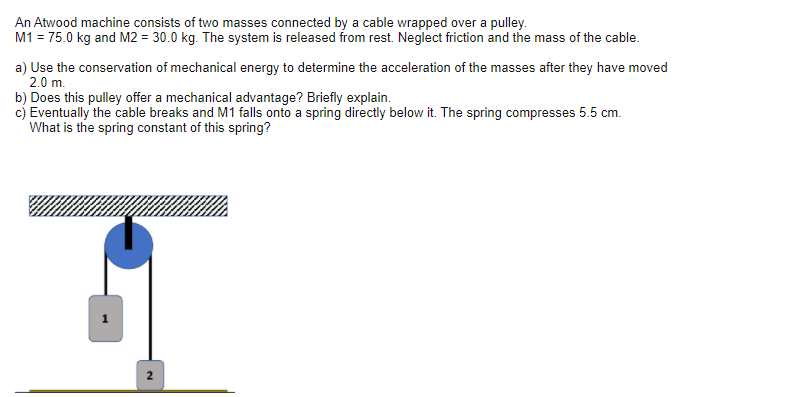An Atwood machine consists of two masses connected by a cable wrapped over a pulley. M1 = 75.0 kg and M2 = 30.0 kg. The system is released from rest. Neglect friction and the mass of the cable. a) Use the conservation of mechanical energy to determine the acceleration of the masses after they have moved 2.0 m. b) Does this pulley offer a mechanical advantage? Briefly explain. c) Eventually the cable breaks and M1 falls onto a spring directly below it. The spring compresses 5.5 cm. What is the spring constant of this spring? 2
An Atwood machine consists of two masses connected by a cable wrapped over a pulley. M1 = 75.0 kg and M2 = 30.0 kg. The system is released from rest. Neglect friction and the mass of the cable. a) Use the conservation of mechanical energy to determine the acceleration of the masses after they have moved 2.0 m. b) Does this pulley offer a mechanical advantage? Briefly explain. c) Eventually the cable breaks and M1 falls onto a spring directly below it. The spring compresses 5.5 cm. What is the spring constant of this spring? 2
College Physics
11th Edition
ISBN:9781305952300
Author:Raymond A. Serway, Chris Vuille
Publisher:Raymond A. Serway, Chris Vuille
Chapter5: Energy
Section: Chapter Questions
Problem 39P: The launching mechanism of a toy gun consists of a spring of unknown spring constant, as shown in...
Related questions
Question
show work

Transcribed Image Text:An Atwood machine consists of two masses connected by a cable wrapped over a pulley.
M1 = 75.0 kg and M2 = 30.0 kg. The system is released from rest. Neglect friction and the mass of the cable.
a) Use the conservation of mechanical energy to determine the acceleration of the masses after they have moved
2.0 m.
b) Does this pulley offer a mechanical advantage? Briefly explain.
c) Eventually the cable breaks and M1 falls onto a spring directly below it. The spring compresses 5.5 cm.
What is the spring constant of this spring?
2
Expert Solution
This question has been solved!
Explore an expertly crafted, step-by-step solution for a thorough understanding of key concepts.
Step by step
Solved in 4 steps

Knowledge Booster
Learn more about
Need a deep-dive on the concept behind this application? Look no further. Learn more about this topic, physics and related others by exploring similar questions and additional content below.Recommended textbooks for you

College Physics
Physics
ISBN:
9781305952300
Author:
Raymond A. Serway, Chris Vuille
Publisher:
Cengage Learning

College Physics
Physics
ISBN:
9781285737027
Author:
Raymond A. Serway, Chris Vuille
Publisher:
Cengage Learning

Physics for Scientists and Engineers
Physics
ISBN:
9781337553278
Author:
Raymond A. Serway, John W. Jewett
Publisher:
Cengage Learning

College Physics
Physics
ISBN:
9781305952300
Author:
Raymond A. Serway, Chris Vuille
Publisher:
Cengage Learning

College Physics
Physics
ISBN:
9781285737027
Author:
Raymond A. Serway, Chris Vuille
Publisher:
Cengage Learning

Physics for Scientists and Engineers
Physics
ISBN:
9781337553278
Author:
Raymond A. Serway, John W. Jewett
Publisher:
Cengage Learning

Physics for Scientists and Engineers with Modern …
Physics
ISBN:
9781337553292
Author:
Raymond A. Serway, John W. Jewett
Publisher:
Cengage Learning

Principles of Physics: A Calculus-Based Text
Physics
ISBN:
9781133104261
Author:
Raymond A. Serway, John W. Jewett
Publisher:
Cengage Learning

College Physics
Physics
ISBN:
9781938168000
Author:
Paul Peter Urone, Roger Hinrichs
Publisher:
OpenStax College